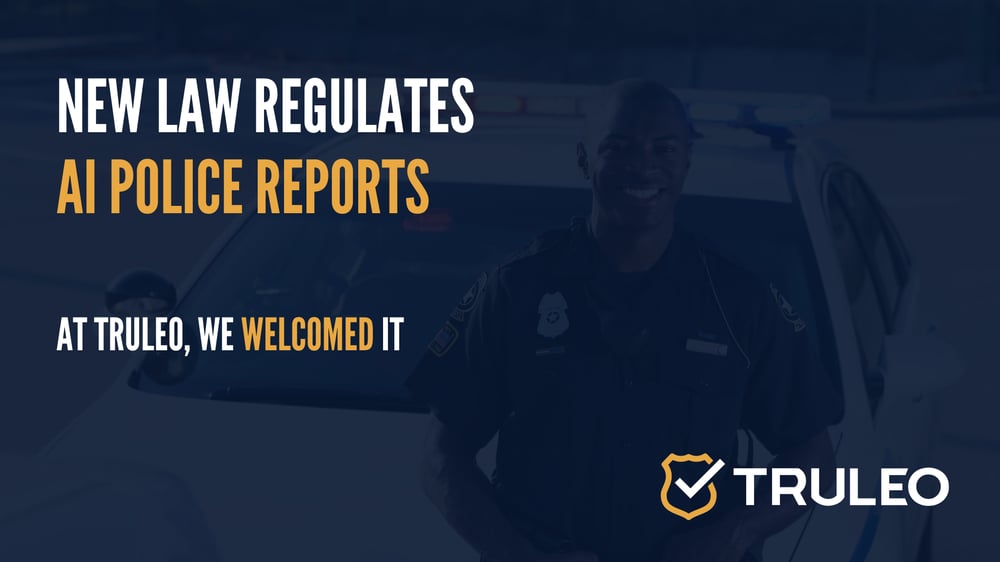New Law Regulates AI Police Reports
Technology Artificial Intelligence Oct 29, 2025 7:16:34 PM Anthony Tassone 3 min read

Senate Bill 524 Targets Vendors Converting Body Camera Videos into Reports.
For many technology vendors, the law’s requirements—mandating full disclosure of AI assistance, retention of every draft, and strict data-handling rules—sparked a rush to re-engineer systems never designed for this level of oversight.
At TRULEO, we welcomed it.
S.B. 524 didn’t disrupt our roadmap—it confirmed we’ve been building automated report writing in the right direction all along. From day one, TRULEO has operated under two guiding principles:
- Protect personally identifiable information (PII): TRULEO never sends PII data to large language models (LLMs).
- Preserve the officer’s perspective: TRULEO’s conversational AI supports officers in writing reports without rewriting their voice or intent.
These principles are the foundation of ethical, transparent, and compliant AI for law enforcement—and the reason TRULEO is already aligned with the future of regulation.
Conversational AI That Keeps the Officer in Command
Artificial intelligence is often misunderstood as a replacement for human judgment. In policing, that assumption is especially dangerous.
Reports are not mechanical summaries; they are personal narratives that capture an officer’s professional reasoning and observations. A well-written report conveys not only facts, but also context, discretion, and accountability.
That’s why TRULEO’s report-writing platform was built as a conversational assistant, not an autonomous author. Our AI guides officers through a dialogue—helping them structure their thoughts, clarify wording, and organize information efficiently—all while keeping their own language and intent intact.
Think of it as a digital notepad—one that listens, prompts, and supports rather than dictates. Every keystroke, prompt, and edit is recorded in a full audit trail. Supervisors and auditors can see exactly which portions were written by the officer and how, if at all, the AI assisted.
This ensures that the officer’s voice remains the primary author of every report. The result: reports that are more accurate, consistent, and timely—without sacrificing authorship integrity. Officers spend less time formatting and more time focusing on the facts.
And because every AI interaction is transparent, agencies meet disclosure and retention requirements with confidence.
Converting BWC into Reports is Lazy and Unethical
TRULEO took a principled stand against converting raw body-camera footage directly into written reports. That shortcut may sound efficient, but it strips the officer of authorship and context—and it introduces unacceptable ethical and legal risks.
Instead, TRULEO enables agencies to maintain a full, visible evolution of every report:
- Judges, defense attorneys, and auditors can trace how a report was built.
- Agency leaders can verify accuracy and accountability.
- Departments can demonstrate good-faith governance in the use of AI.
Transparency should never be a compliance burden—it should be an operational advantage. TRULEO customers don’t need to retrofit their workflows to meet new laws; they’re already there.
Why Authorship Integrity Matters
As agencies adopt AI tools, one of the most critical ethical questions is authorship: Who is truly writing the report?
If an AI system rewrites or replaces officer text, it risks distorting meaning and altering the tone of the report—potentially with legal consequences.
TRULEO solves this problem by preserving authorship integrity. The officer’s input is never overridden, only supported. The AI assists in structuring, not storytelling.
This distinction is vital. It keeps officers accountable for their own words while providing modern tools to improve clarity and efficiency. In short, TRULEO doesn’t automate judgment—it enhances it.
The Regulatory Momentum is Just Beginning
California is now the second state, after Utah, to enact AI transparency legislation, and more will follow. For agencies, this marks a permanent shift: transparency, auditability, and data control are now minimum entry requirements for any AI used in public safety.
For vendors, it means redesigning products from the ground up. Without version tracking, authorship attribution, and secure data governance, agencies face legal and reputational risk.
TRULEO customers don’t face that risk—our systems were architected for transparency from the start.
CONCLUSION: TRULEO is the Standard
As states continue to legislate AI transparency, one truth stands out: responsible innovation is no longer optional.
Agencies must ensure their technology partners meet the highest standards of data protection and authorship integrity. Those that do will not only comply with the law—they’ll build public trust.
At TRULEO, we’re proud to be ahead of that curve. Our platform was built to respect privacy, preserve human judgment, and provide full transparency in every AI interaction.
The next era of law enforcement technology will belong to those who design for trust, not shortcuts—for accountability, not convenience.
TRULEO has been leading that charge from the beginning.

Anthony Tassone
Anthony comes from a proud military and law enforcement family, built communication intelligence platforms (COMINT), and serves as a board member of the FBI National Academy Associates (FBINAA) Foundation. He travels the country teaching trusted law enforcement leadership organizations—such as FBI LEEDS—about the practical use of artificial intelligence in policing. He received his bachelor’s degree in Computer Science from DePaul University and lives in Greenville South Carolina with his wife and four kids and is an avid bowhunter, rescue diver and triathlete.